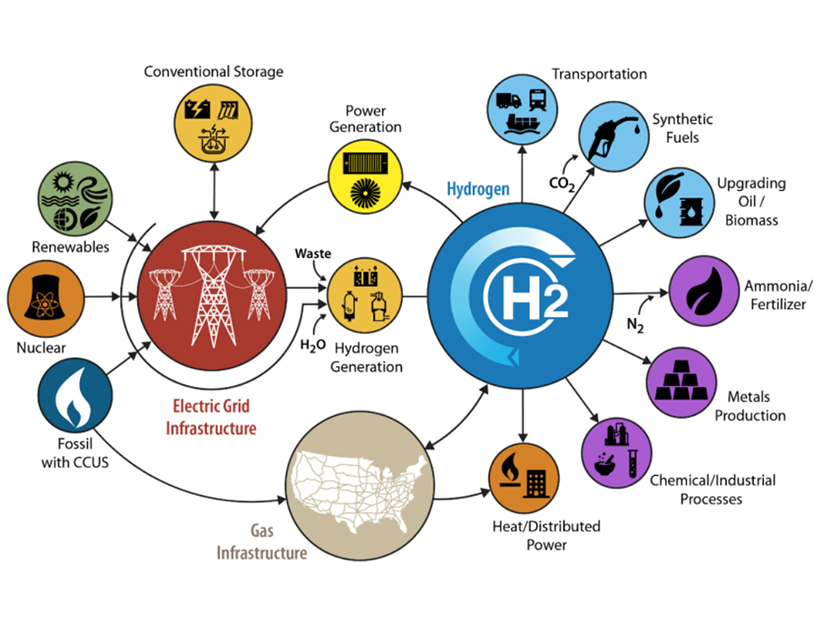
The White House on Tuesday continued its execution of the Infrastructure Investment and Jobs Act (IIJA) with a new group of requests for information (RFIs) and guidance documents, this time aimed at hard-to-decarbonize industrial products, including steel, aluminum and concrete.
The Department of Energy issued two RFIs, one on the IIJA’s $8 billion allocation to develop four clean hydrogen hubs across the country, and a second on the $1.5 billion in funding for research and development for clean hydrogen manufacturing and recycling.
The White House Council on Environmental Quality (CEQ) also issued draft guidelines for federal agencies on “responsible deployment” of carbon capture, utilization and sequestration (CCUS) projects. The IIJA provides $3.5 billion for CCUS demonstration and pilot projects and another $2.5 billion for low-interest loans for CO2 pipelines.
Other initiatives outlined in a White House fact sheet include:
- the creation of a Buy Clean Task Force to “harness the federal government’s massive purchasing power to support low-carbon materials made in American factories”;
- a new Technology Innovation Advisory Committee charged with “creating a comprehensive strategy to lower the carbon footprint of America’s industrial base”; and
- trade policy being developed with the EU to keep “dirty steel” out of U.S. and European markets and limit steel dumping.
“The industrial sector is … central to tackling the climate crisis, as it is currently responsible for nearly a third of domestic greenhouse gas emissions,” the administration said. “By helping manufacturers use clean energy, efficiency upgrades and other innovative technologies to reduce emissions, the administration is supporting cleaner industry that can produce the next generation of products and materials for a net-zero economy.”
“With industries moving quickly to adopt and deploy carbon capture technologies, federal agencies can play a key role in ensuring that projects are done right and in a way that reflects the needs and inputs of local communities,” CEQ Chair Brenda Mallory said. The new guidelines are a first step toward CCUS “deployment in a manner that is environmentally sound and that cuts cumulative pollution in nearby communities.”
The hydrogen RFIs are part of DOE’s Hydrogen Shot, another initiative aimed at reducing the cost of clean hydrogen by 80% over the next decade, from the current price of about $5/kg to $1. According to the RFI on hydrogen hubs, “co-locating large-scale clean hydrogen production with multiple end uses can foster the development of low-cost hydrogen and the necessary supporting infrastructure to jumpstart the hydrogen economy in various market segments, create both near-term and long-term jobs and tax revenues for regional economies, and realize emissions-reduction benefits.”
The IIJA requires that the four hubs must each be located in different areas of the country; use different fuels, including natural gas, renewable energy and nuclear; and demonstrate applications in different industries: electricity, transportation, industry, and residential and commercial heating.
“Clean hydrogen is key to cleaning up American manufacturing and slashing emissions from carbon-intensive materials like steel and cement.” Energy Secretary Jennifer Granholm said in a statement. The goal is to help make “scaling up this clean, affordable energy source a reality for the United States.”
CEQ Guidelines
The guidelines for carbon capture and storage recognize the complex challenges that will be involved in permitting these projects. A demonstration project on federal land could trigger environmental assessments under the National Environmental Policy Act, Endangered Species Act and the Clean Air Act.
For example, to streamline permitting, the guidelines suggest that agencies develop “programmatic environmental reviews … where such analyses can facilitate more efficient and effective environmental reviews of multiple projects while maintaining community engagement.”
For building out a network of pipelines for CO2 transport and sequestration, the guidelines call for “close monitoring and enforcement of existing regulations and development of new tools to monitor and improve safety while also reducing the number of incidents that result in leakage of carbon dioxide.”
Jessie Stolark, policy and member relations manager for the Carbon Capture Coalition, said the clean industry initiatives reflect “broad, bipartisan support for the economywide deployment of carbon management technologies and further [underscore] President Biden’s commitment to utilizing carbon management as a critical tool to decarbonize heavy industry and manufacturing.”
“Federal investment in industrial decarbonization is key to American prosperity and to putting domestic industry firmly on the path toward deep emissions reductions, retaining and creating high-wage jobs, and continued technology leadership and economic competitiveness,” Stolark said.
On Thursday, DOE and the Department of Transportation announced the first round of state allocations for the $5 billion in the law to help states deploy electric vehicle chargers along main transportation corridors. (See States to Get $615 Million for EV Charging from IIJA Funds.)
DOE also released state guidelines for applying for the money, and the White House has issued a 465-page guidebook to help the states navigate all the IIJA funding opportunities.


